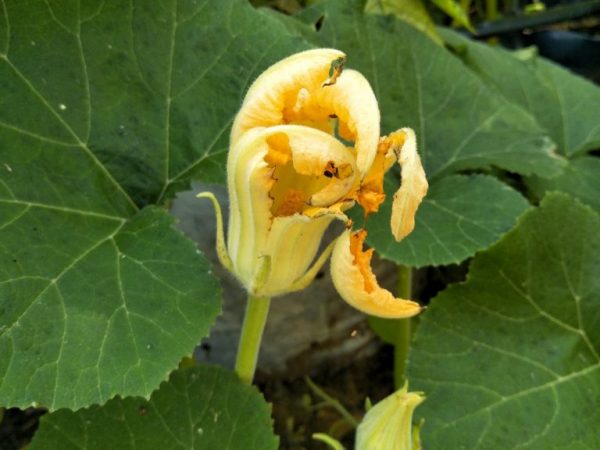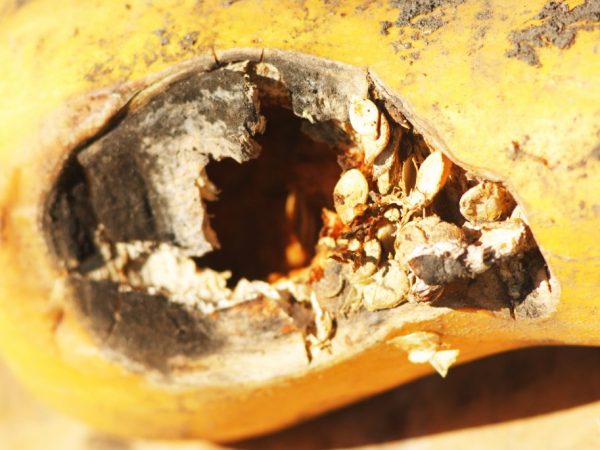Causes of yellowing of zucchini
It is necessary to strictly follow the rules for planting zucchini and caring for them in order to preserve the vegetable crop. Consider why zucchini turn yellow and leaves rot and how can this be avoided?

Causes of yellowing of zucchini
Causes of yellowing of leaves
Young zucchini give many ovaries, while some of them turn yellow and fall off - this is a normal natural phenomenon.
But a sharp yellowing of seedlings, the culture itself and the fruits should alert.
It is especially frightening if this happens at the beginning of the season, when they are not yet ripe and must grow before the end of summer.
Possible reasons
Cold
Zucchini are powerful in appearance, but their leaf structure is loose and very vulnerable.
Too cold weather or sudden temperature changes in late spring make them weaker, which causes crop disease and yellowing.
To avoid this, it is advised to plant the crop in open ground no earlier than June; you can plant it in the greenhouse in May.
Improper watering
Young zucchini need a lot of moisture. This can only be ensured by regular watering and soil moistening.
Improper irrigation leads to yellowing of the tips of the leaves.
The correct time to water is early morning. The second option is evening. During the day, when the sun is shining, the moisture-covered leaves are burned by its rays. Such a burn is the cause of the appearance of yellow spots on the plant.
Unsuitable soil
The acidic soil is not suitable for zucchini - because of this, the leaves turn yellow, and the culture itself withers.
Before planting seedlings, ash and humus are added to the pits - this will saturate the earth with organic matter and qualitatively reduce the acidity of the soil.
Lack of nutrients

Finding out the reason
Due to their deficiency, plants lag behind in development in comparison with healthy powerful seedlings. The ovary may not form, and the leaves may turn yellow.
Uniform yellowness indicates a lack of nitrogen.
For feeding zucchini, drugs with this element are used. Fertilizer in the form of infusion of nettle and ash is also suitable.
Planting density
Lack of lighting also causes yellowness. To ensure the flow of light to the plants, it is better not to plant zucchini densely and thin out only if necessary.
If the leaves do turn yellow, they are removed to prevent decay. It quickly spreads throughout the plant - it is important to have time to prevent its development in time.
Diseases and pests
Powdery mildew
It is often the reason why the leaves of zucchini turn yellow.
First, yellow spots appear on the inside of young leaves, then the plant turns brown.
Complete drying out indicates that the disease has completely destroyed the culture.
The following factors lead to the reproduction of the fungus:
- excess nitrogen and calcium deficiency;
- frequent watering or rain;
- small distance between bushes;
- abundance of weeds in the garden.
Dew treatment is a complex process. To prevent its development, preventive measures are taken even at the sowing stage:
- soak the seeds a day before planting in warm water;
- periodically air the seedlings;
- do not overmoisten.
Anthracnose
It is more common when growing seedlings in a greenhouse.
It is represented by light blurry spots that make the leaves burned by the sun's rays. Anthracnose transfers to fruits and causes them to rot.
As a preventive measure, greenhouses are disinfected and plant residues are removed from the open ground after harvesting.
Spider mite
Destroys zucchini outside and inside. The first symptoms are yellowing of the tops. A thin web appears on the back side, where pests live. They acquire a mosaic structure, turn yellow and die off.
Chlorosis
Chlorosis can be caused by the lack of loosening, which is practically carried out so that the roots do not suffocate.
Leaves can also deteriorate due to this disease.
Slugs
Gardeners plant sage or lavender, mustard, garlic and pepper near zucchini. These natural remedies are enough to keep plants free of these insects. They also use ground superphosphate.
Other pests affect the sprouts more, but they often lead to a decrease in its yield.
To scare away sprout flies and whiteflies, conifer needles are laid around the zucchini.
Why do seedling leaves turn yellow

All problems start with seedlings
Often not only mature bushes acquire yellow color. This problem also occurs with seedlings. Even at the stage of its cultivation, the border may turn yellow at the edges, then the plate twists and falls off. The most common reason for this is nitrogen deficiency.
The culture can be saved only at the initial stage of yellowing. If most of the leaves are damaged, remove the damaged seedlings and prepare new ones.
After 12-14 days, after the seedlings appear from the ground, they are fed with nitrogen-containing fertilizers.
This good prevention will prevent yellowing and make the plant resistant to weather problems.
Larger pots are used for seedlings than for other vegetables. If there are no special reasons for yellowing, larger diameter containers are selected for seedlings.
Why do the ovaries turn yellow
If the zucchini turn yellow and dry when they are tied, the volume of the harvested crop also decreases.
A common reason is non-observance of the necessary techniques during flowering b.
This leads to a decrease in immunity, an imbalance of substances in the soil, an increased risk of fungal infection and a lack of pollination.
To avoid problems, in the morning they pick a male flower that grows on a long stem, and remove the petals from it. A stamen is carried over the pistil of a female flower - its leg is shorter. The bud is used for 2-3 flowers, then a new one is taken.
Reasons for yellowing of embryos:
- excess moisture - for prevention, loosen the ground and remove the lower leaves;
- lack of water;
- illness;
- deficiency or abundance of micronutrients;
- high temperature - if it's hot outside, zucchini are protected from the sun by fabric canopies and are often watered;
- pests - they affect the ovaries as well as adult plants.
Methods of dealing with yellowness
If powdery mildew has already appeared on the zucchini, the plant is treated with Bordeaux liquid or copper oxychloride.
As a treatment, you can use a solution of liquid soap and baking soda - they are taken in a teaspoon and dissolved in 2 liters of warm water. The finished mixture is sprayed on the site in dry weather.
If the reason is anthracnose, you can fight using the following procedures:
- removal of diseased seedlings;
- elimination of affected crops, if they have grown up, but did not go into bloom;
- in the greenhouse, vegetables are sprayed with colloidal sulfur, on open ground - with Bordeaux liquid.
There are several folk remedies to help get rid of spider mites:
- For 10 liters of water, take 1 kg of ash and 200 g of grated laundry soap. Plants are treated every other day until the tick is removed.
- Using potato tops. They chop it down and fill it with water. After insisting in a closed container for 7-8 days, the product is ready.It can be used every day.
- For 7-8 days, 2 heads of garlic, 500 g of ash and half a bucket of chamomile broth are insisted. To prepare it, take 100 g of dry raw materials. The culture is processed every 2 days. It will take 3-4 times.
Prevention measures
To preserve the harvest, preventive measures are taken. To prevent the fruits from turning yellow from nutritional deficiencies, they are fed with organic substances and nitrogen-containing fertilizer.
To avoid waterlogging, avoid excessive watering - especially on shoots and on rainy days. Supports normal plant growth and fungicides contained onion peel and garlic.
It is useful to process the culture with urea, vitriol, boric acid. This can be done 2 times, with an interval of 12-14 days, from planting seedlings to the appearance of the ovary.
The only time the leaves turn yellow is at the end of the growing season. This means vegetables can be picked and stored.

